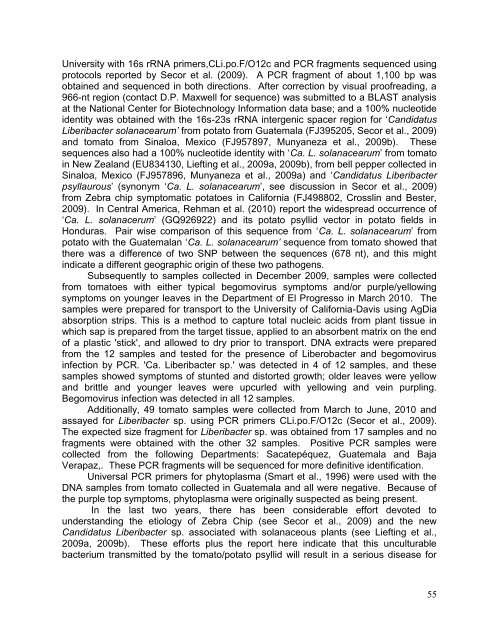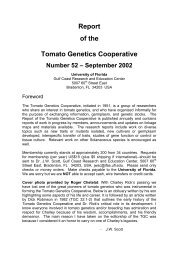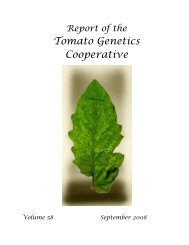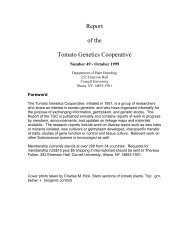Volume 60 - Tomato Genetics Cooperative - University of Florida
Volume 60 - Tomato Genetics Cooperative - University of Florida
Volume 60 - Tomato Genetics Cooperative - University of Florida
You also want an ePaper? Increase the reach of your titles
YUMPU automatically turns print PDFs into web optimized ePapers that Google loves.
<strong>University</strong> with 16s rRNA primers,CLi.po.F/O12c and PCR fragments sequenced using<br />
protocols reported by Secor et al. (2009). A PCR fragment <strong>of</strong> about 1,100 bp was<br />
obtained and sequenced in both directions. After correction by visual pro<strong>of</strong>reading, a<br />
966-nt region (contact D.P. Maxwell for sequence) was submitted to a BLAST analysis<br />
at the National Center for Biotechnology Information data base; and a 100% nucleotide<br />
identity was obtained with the 16s-23s rRNA intergenic spacer region for „Candidatus<br />
Liberibacter solanacearum’ from potato from Guatemala (FJ395205, Secor et al., 2009)<br />
and tomato from Sinaloa, Mexico (FJ957897, Munyaneza et al., 2009b). These<br />
sequences also had a 100% nucleotide identity with „Ca. L. solanacearum‟ from tomato<br />
in New Zealand (EU834130, Liefting et al., 2009a, 2009b), from bell pepper collected in<br />
Sinaloa, Mexico (FJ957896, Munyaneza et al., 2009a) and „Candidatus Liberibacter<br />
psyllaurous‟ (synonym „Ca. L. solanacearum‟, see discussion in Secor et al., 2009)<br />
from Zebra chip symptomatic potatoes in California (FJ498802, Crosslin and Bester,<br />
2009). In Central America, Rehman et al. (2010) report the widespread occurrence <strong>of</strong><br />
„Ca. L. solanacerum‟ (GQ926922) and its potato psyllid vector in potato fields in<br />
Honduras. Pair wise comparison <strong>of</strong> this sequence from „Ca. L. solanacearum‟ from<br />
potato with the Guatemalan „Ca. L. solanacearum’ sequence from tomato showed that<br />
there was a difference <strong>of</strong> two SNP between the sequences (678 nt), and this might<br />
indicate a different geographic origin <strong>of</strong> these two pathogens.<br />
Subsequently to samples collected in December 2009, samples were collected<br />
from tomatoes with either typical begomovirus symptoms and/or purple/yellowing<br />
symptoms on younger leaves in the Department <strong>of</strong> El Progresso in March 2010. The<br />
samples were prepared for transport to the <strong>University</strong> <strong>of</strong> California-Davis using AgDia<br />
absorption strips. This is a method to capture total nucleic acids from plant tissue in<br />
which sap is prepared from the target tissue, applied to an absorbent matrix on the end<br />
<strong>of</strong> a plastic 'stick', and allowed to dry prior to transport. DNA extracts were prepared<br />
from the 12 samples and tested for the presence <strong>of</strong> Liberobacter and begomovirus<br />
infection by PCR. 'Ca. Liberibacter sp.' was detected in 4 <strong>of</strong> 12 samples, and these<br />
samples showed symptoms <strong>of</strong> stunted and distorted growth; older leaves were yellow<br />
and brittle and younger leaves were upcurled with yellowing and vein purpling.<br />
Begomovirus infection was detected in all 12 samples.<br />
Additionally, 49 tomato samples were collected from March to June, 2010 and<br />
assayed for Liberibacter sp. using PCR primers CLi.po.F/O12c (Secor et al., 2009).<br />
The expected size fragment for Liberibacter sp. was obtained from 17 samples and no<br />
fragments were obtained with the other 32 samples. Positive PCR samples were<br />
collected from the following Departments: Sacatepéquez, Guatemala and Baja<br />
Verapaz,. These PCR fragments will be sequenced for more definitive identification.<br />
Universal PCR primers for phytoplasma (Smart et al., 1996) were used with the<br />
DNA samples from tomato collected in Guatemala and all were negative. Because <strong>of</strong><br />
the purple top symptoms, phytoplasma were originally suspected as being present.<br />
In the last two years, there has been considerable effort devoted to<br />
understanding the etiology <strong>of</strong> Zebra Chip (see Secor et al., 2009) and the new<br />
Candidatus Liberibacter sp. associated with solanaceous plants (see Liefting et al.,<br />
2009a, 2009b). These efforts plus the report here indicate that this unculturable<br />
bacterium transmitted by the tomato/potato psyllid will result in a serious disease for<br />
55





